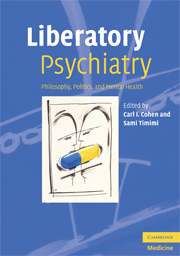Book contents
- Frontmatter
- Contents
- Contributors
- Acknowledgments
- Introduction
- 1 Working towards a liberatory psychiatry? Radicalizing the science of human psychology and behavior
- 2 Power, freedom, and mental health: a postpsychiatry perspective
- 3 Challenging risk: a critique of defensive practice
- 4 Democracy in psychiatry: or why psychiatry needs a new constitution
- 5 German critical psychology as emancipatory psychology
- 6 Psychopolitical validity in the helping professions: applications to research, interventions, case conceptualization, and therapy
- 7 Class exploitation and psychiatric disorders: from status syndrome to capitalist syndrome
- 8 Ecological, individual, ecological? Moving public health psychiatry into a new era
- 9 Children's mental health and the global market: an ecological analysis
- 10 Postcolonial psychiatry: the Empire strikes back? Or, the untapped promise of multiculturalism
- 11 A new psychiatry for a new world: postcolonialism, postmodernism, and the integration of premodern thought into psychiatry
- 12 Neoliberalism and biopsychiatry: a marriage of convenience
- 13 Psychoanalysis and social change: the Latin American experience
- 14 A new psychiatry?
- Index
- References
12 - Neoliberalism and biopsychiatry: a marriage of convenience
Published online by Cambridge University Press: 25 August 2009
- Frontmatter
- Contents
- Contributors
- Acknowledgments
- Introduction
- 1 Working towards a liberatory psychiatry? Radicalizing the science of human psychology and behavior
- 2 Power, freedom, and mental health: a postpsychiatry perspective
- 3 Challenging risk: a critique of defensive practice
- 4 Democracy in psychiatry: or why psychiatry needs a new constitution
- 5 German critical psychology as emancipatory psychology
- 6 Psychopolitical validity in the helping professions: applications to research, interventions, case conceptualization, and therapy
- 7 Class exploitation and psychiatric disorders: from status syndrome to capitalist syndrome
- 8 Ecological, individual, ecological? Moving public health psychiatry into a new era
- 9 Children's mental health and the global market: an ecological analysis
- 10 Postcolonial psychiatry: the Empire strikes back? Or, the untapped promise of multiculturalism
- 11 A new psychiatry for a new world: postcolonialism, postmodernism, and the integration of premodern thought into psychiatry
- 12 Neoliberalism and biopsychiatry: a marriage of convenience
- 13 Psychoanalysis and social change: the Latin American experience
- 14 A new psychiatry?
- Index
- References
Summary
Introduction
Since the end of the 1970s there has been a change in the nature and activity of institutional psychiatry. Neuroscience research, which aims to uncover the biological origins of psychiatric disorders, has burgeoned and flourished, gaining a high degree of credibility outside psychiatry as well as within (Cohen, 1993). In addition, psychiatry is no longer confined within the walls of an asylum, ministering to the severely disturbed, but now plies its wares to a widening proportion of the population. Use of psychiatric drugs has risen dramatically. In the UK, for example, prescriptions for antidepressants rose by 235% in the 10 years up to 2002 (National Institute for Clinical Excellence, 2004). In the USA 11% of women and 5% of men now take an antidepressant drug (Stagnitti, 2005). A larger proportion of the general population are now willing to identify themselves as needing psychiatric help and psychiatry has become a more confident and biologically inclined profession.
These developments in psychiatry parallel profound social and economic changes, referred to here as “neoliberalism,” that have occurred to varying degrees throughout the world. The question I shall address in this chapter is whether these two developments are related. Does a newly invigorated biologically oriented psychiatry help to create the social and cultural milieu favoured by neoliberal policies? Have those policies in turn helped a certain view of psychiatry to become hegemonic?
Psychiatry and economics
Psychiatry has always had an intimate relationship with economics.
- Type
- Chapter
- Information
- Liberatory PsychiatryPhilosophy, Politics and Mental Health, pp. 235 - 256Publisher: Cambridge University PressPrint publication year: 2008
References
- 9
- Cited by

